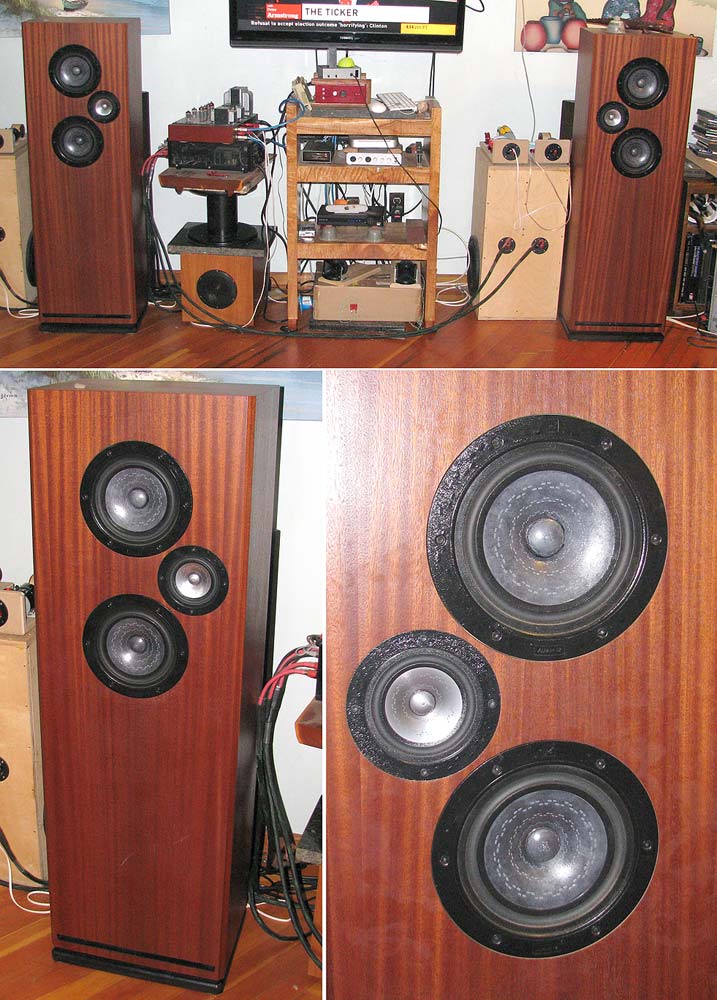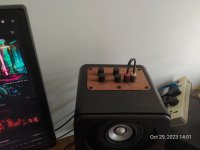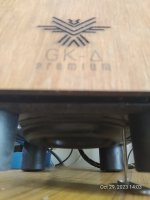I've been investigating MarkAudio drivers & I'm itching to try a design. It occurred to me that a 4" driver (like the inexpensive CHR-70) mated with a low cost high efficiency 6" or 8" bass driver could simultaneously achieve baffle step compensation & relieve the load on the 4" driver, when crossed over at the baffle step frequency. A double chamber bookshelf style box is required, no biggie. The crossover could be fairly simple too. Has anyone published a DIY design along these lines? Thanks in advance!
There are quite a few around. They are often referred to as WAW or FAST speakers.
Woofer assisted Widerange.
Woofer assisted Widerange.
This one came to mind using all MA drivers. https://www.markaudio.com/wp-content/uploads/2023/07/Alpair-7MS-CHR120-compound-load.pngCould you point me to examples using MA (or a combination of) drivers?
jeff
This might get you going
https://www.diyaudio.com/community/...king-for-recommendations.356127/#post-6247883
Jeremy
https://www.diyaudio.com/community/...king-for-recommendations.356127/#post-6247883
Jeremy
Thanks but the design wastes the CHR-120's bandwidth. I had in mind a cheap woofer. I'll look at the other suggestions!This one came to mind using all MA drivers. https://www.markaudio.com/wp-content/uploads/2023/07/Alpair-7MS-CHR120-compound-load.png
jeff
What a beautiful speaker!
If it isn't a foolish question -I don't quite understand how it 'wastes the CHR-120's bandwidth' when the CHR-120 is either run without any filtering at all, or an optional, very low value inductor to reduce output lobing at the top end of the BW -the maximum value I suggested for it being 0.5mH, with the exact figure (if it's even used) being left to the discretion of the user.Thanks but the design wastes the CHR-120's bandwidth. I had in mind a cheap woofer. I'll look at the other suggestions!

These compound designs aren't traditional low-crossed 2-ways, but hybrids & in a sense approached more like single-driver systems. I'm working on a few 2-way designs using the MA units, but it's slow going as I don't have much in the way of facilities (or drivers available) at present.
Last edited:
If both drivers are operated wideband how is baffle step compensation achieved (without using a lossy network)? Assume a narrow baffle bookshelf style box. My original intention was to have the woofer provide baffle step compensation & only operate below the baffle step frequency (low passed). Compensation is achieved by using a woofer with a higher acoustical efficiency than the MA driver. Efficiency may come about electrically and/or acoustically (difference in cone areas?). The MA driver is high passed. This approach emphasises low cost, power handling & efficiency (which is what MA is all about).
A point about step-loss that's often overlooked is that the actual on-baffle response depends on the driver's own response trend. Most of the time it's assumed that they start out with a flat LF response, so will (in free-space) see a -6dB shelving trend below that. There are a few caveats that come into play there though: firstly not all drive units actually have a flat response in the LF under IB / IEC baffle conditions, so if under those they have a rising response with descending frequency (as most of the MA units have) then this largely cancels out the real-world losses. And related to that -we call it 'loss' but in the majority of practical conditions it's not a generalised loss as such: the acoustic power is theoretically spread over a wider angle / hemisphere, but it's rare that it entirely vanishes: you'd need a very lossy room construction & damping for that (basically an anechoic chamber, or as near-as) which is why in multiway design we don't always build a perfectly flat response into the speaker < 1KHz or so, unless the speaker is intended for acoustically large spaces & positioned well away from boundaries. There are other aspects of course, but those are the two main ones that have wider applicability.
I'm still a bit stumped about how the CHR-120's bandwidth is being wasted in the above though. 😉 I'm not saying it's perfect (it isn't: it was deliberately designed as a fairly left-field enclosure, albeit mainly in terms of the compound driver box loading), but since it's got at best a very mild low-pass on it, I don't see where the waste is.
I'm still a bit stumped about how the CHR-120's bandwidth is being wasted in the above though. 😉 I'm not saying it's perfect (it isn't: it was deliberately designed as a fairly left-field enclosure, albeit mainly in terms of the compound driver box loading), but since it's got at best a very mild low-pass on it, I don't see where the waste is.
In my opinion, for mid/tweeter, I've selected:
A- CHN-50 $19.90
B- A 5.3 $47.70
C- P7HD $49.70
B- A 7MS $76.00
For bass:
1- SB20PFCR30-* $54.00
2- Dayton RS225-* $84.98~$89.98
3- MA A12PW $?
Active XO from XKitz 350~450 hz
2 Amplifiers 2 CH. From 3e Audio
Employing the Nanotyrannus cabinet from Planet10.
Gus.
A- CHN-50 $19.90
B- A 5.3 $47.70
C- P7HD $49.70
B- A 7MS $76.00
For bass:
1- SB20PFCR30-* $54.00
2- Dayton RS225-* $84.98~$89.98
3- MA A12PW $?
Active XO from XKitz 350~450 hz
2 Amplifiers 2 CH. From 3e Audio
Employing the Nanotyrannus cabinet from Planet10.
Gus.
Attachments
Last edited:
The 12PW is out of production. Might be able to find somewhere that stocked it. I know Madisound is out.
Nanotyrannus cabinet from Planet10
From Woden Design.
Scott’s design, i did the drawings (and helped with the midTLs).
dave
I'm new to this but I consider the CHR-120 wideband & wasted in a design only intended to operate to a 500-700Hz baffle step frequency?A point about step-loss that's often overlooked is that the actual on-baffle response depends on the driver's own response trend. Most of the time it's assumed that they start out with a flat LF response, so will (in free-space) see a -6dB shelving trend below that. There are a few caveats that come into play there though: firstly not all drive units actually have a flat response in the LF under IB / IEC baffle conditions, so if under those they have a rising response with descending frequency (as most of the MA units have) then this largely cancels out the real-world losses. And related to that -we call it 'loss' but in the majority of practical conditions it's not a generalised loss as such: the acoustic power is theoretically spread over a wider angle / hemisphere, but it's rare that it entirely vanishes: you'd need a very lossy room construction & damping for that (basically an anechoic chamber, or as near-as) which is why in multiway design we don't always build a perfectly flat response into the speaker < 1KHz or so, unless the speaker is intended for acoustically large spaces & positioned well away from boundaries. There are other aspects of course, but those are the two main ones that have wider applicability.
I'm still a bit stumped about how the CHR-120's bandwidth is being wasted in the above though. 😉 I'm not saying it's perfect (it isn't: it was deliberately designed as a fairly left-field enclosure, albeit mainly in terms of the compound driver box loading), but since it's got at best a very mild low-pass on it, I don't see where the waste is.
I prefer the sound of speakers that are flat to <100Hz, as measured on a Klippel scanner. My present speakers have 4dB boost at 150Hz, that is unpleasant when only recently listening to FM radio male announcers. I have corrected them with an electronic Twin-T notch filter but the speaker's design is a bad set of compromises. To be fair, they were well reviewed & I auditioned them in a large room with no close reflecting surfaces, I won't make that mistake again!
Scott, from your your first paragraph I cannot understand whether my basic objective is a good or bad idea?
You will find quite a few. The concept is very solid. It eliminates much of the evil of XOs (by getting the drivers within a quarter wavelength at XO), maximizes FR’s midTop performance, has as much bass as you are willing to afford (soze & $$), as well as the opportunity to dial in the right amount of BSC.
I could post pictures of at least a half-dozen.
If you are on a budget, Tysen V2 has somethign like a $200 driver budget (less with CHN-50 [an absolute bargain]), or all the way to things like the WAW i helped design with A7.3 and a pair of push-push scan woofers.
Things like Halcyon, our big MTM, Scott’s Nanotyrannus are limited by NLA woofers.

dave
I could post pictures of at least a half-dozen.
If you are on a budget, Tysen V2 has somethign like a $200 driver budget (less with CHN-50 [an absolute bargain]), or all the way to things like the WAW i helped design with A7.3 and a pair of push-push scan woofers.
Things like Halcyon, our big MTM, Scott’s Nanotyrannus are limited by NLA woofers.

dave
I'm new to this but I consider the CHR-120 wideband & wasted in a design only intended to operate to a 500-700Hz baffle step frequency?
It helps with the XO if the bass driver is very extended. In Tysen they do 5kHz, in the one above 10k, the one with the poorest bandwidth goes to 1.7 kHz (but is XOed at 200 Hz),
The bass driver should be evaluated on its bass performance. And how well its voicing matches the midTweeter.
A 500 Hz XO is high, 250-450 is a more common range. If we are doing a 20-20k speaker the half-way point is 320 Hz (5 octaves above, 5 below).
dave
A 500Hz XO is high if the woofer is side firing, not if front firing.
By voicing I assume you mean similar cone materials?
Understood on XOs & wideband drivers! Always true!!
By voicing I assume you mean similar cone materials?
Understood on XOs & wideband drivers! Always true!!
- Home
- Loudspeakers
- Full Range
- Markaudio: has anyone designed something like this?


